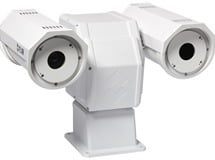IT goes without saying that while video surveillance is a powerful tool for security managers, there are times when usable video is extremely difficult to obtain – particularly at night, at extreme distances and during extremes of weather.
Making light of these challenges, thermal security cameras make pictures from heat not light, so they can see clearly in total darkness and through smoke, dust and light fog. They allow security managers to see more and farther than any other night vision technology on the market today, even in bright sunlight.
By combining FLIR’s thermal security cameras and the FLIR Sensors Manager (FSM) control and management software, the FLIR Thermal Fence provides automated perimeter surveillance, intrusion detection, and alert capabilities for perimeter security applications. The optional nDVR Sensor Activity Recorder provides integrated alarm and activity recording capability over a Thermal Fence.
Incorporating FLIR’s IP thermal security cameras, the FLIR Thermal Fence gives you instant, automated threat detection and visual threat assessment capability around the clock in one easy-to-use package. Its thermal security cameras are fully networked with FLIR Sensors Manager, a comprehensive sensor management software package that lets you manage the alarms from a range of third-party sensor manufacturers, including fence sensors, ground sensors, radars, seismic sensors, and fiber nets.
This ability makes Thermal Fence a powerful perimeter security and alarm detection and assessment tool for high security residential installations, corporate campuses, petrochemical facilities, power generation and transmission facilities, and everything in between.
The integral geo-referenced mapping function features FLIR’s unique slew-to-cue function, which commands FLIR’s pan/tilt IP thermal security cameras to point at the precise coordinates of any alarm generated by any sensor on a FLIR Thermal Fence network. This allows the operator to immediately perform a visual inspection of the alarm, expediting a human response to the event.
FSM’s advanced video analytics use algorithms specifically designed to work with thermal video, allowing you to create customized rules for trip wires, exclusion zones, temperature alarms, and directional alarming while providing a much lower rate of false alarms than other analytics packages.
Less expensive than installing a new physical barrier, and less intrusive than an expensive lighting infrastructure, the FLIR Thermal Fence allows security professionals to augment their alarm detection and assessment capabilities along existing physical fence lines.
Thermal Fence can establish a virtual perimeter in areas that cannot be fenced due to economic, environmental, or logistical restrictions allowing security managers to bolster the security of critical zones within existing secured perimeters by creating exclusion zones and establishing concentric rings of increasingly stringent security coverage.
FLIR’s Thermal Fence allows optimization of the focal lengths of FLIR thermal security cameras to reduce total cost of installation-related infrastructure such as power, poles, trenching, cabling, head end, storage, and network bandwidth. Importantly, it’s easy to modify and expand a thermal fence quickly and easily thanks to Thermal Fence’s modularity and flexibility.
FLIR Thermal Fence operates over the same IP network as existing CCTV camera networks and displays all of your thermal camera video and other sensor outputs on a single convenient display. All of thermal cameras and other perimeter security sensors are fully integrated and geo-referenced on a map of your facility for rapid detection and threat assessment, allowing you to deploy your assets efficiently, effectively, and to their full advantage.
Thanks to that geo-referencing function, FLIR’s Thermal Fence offers a high level of detection accuracy. What does geo-referencing means? Essentially this capability means the exact location of all the sensors in a Thermal Fence are know the precisely so operators know the location of an intrusion. Not only does the Thermal Fence know were each sensor is – every sensor on the network knows where the other sensors are as well.
Let’s say a fence sensor gets tripped and sends out an alarm. Your FLIR pan/tilt cameras know where that fence sensor is, and the closest one will point to the alarm area giving you instant visual confirmation of the alerts provided by your non-video alarm systems. This extreme interoperability lets you respond quickly and efficiently to real alarms, and virtually eliminate responses to false alarms.
Because FLIR Thermal Fence operates in parallel with your existing security video network, there’s no disruption to that network while you implement the Thermal Fence, and no expense incurred for re-training on a new CCTV sensor networking solution. Instead the FLIR Thermal Fence provides built-in redundancy, so that even if your VMS goes down, a Thermal Fence and all of its affiliated sensors will still function.
Click to Bookmark Post
Post Bookmarked
22.8
C
Sydney
17.3
C
Canberra
28
C
Darwin
18.5
C
Hobart
16
C
Perth
21.8
C
Brisbane
19.4
C
Auckland
28
C
Melbourne










